
On August 7, 2020, the Patent Trial and Appeal Board issued a decision in Ex parte Koseoglu (Appeal 2019-002720) and reversed an obviousness rejection of a catalyst composition. Implicit in the Board’s decision was the determination that one of the catalyst components, having only an upper limit on its amount, was present in the catalyst composition.
Claim 10 on appeal is representative and reads:
10. A catalyst composition useful in oxidative desulfurization of a sulfur-containing hydrocarbon, comprising:
copper oxide in an amount ranging from 10 weight percent to 50 wt.%,
zinc oxide in an amount ranging from 5 wt.% to less than 20 wt.%,
aluminum oxide in an amount ranging from 20 wt.% to 70 wt.%, and
at least one Group VIB metal oxide promoter, in an amount up to 20 wt.% of said catalytic composition.
The Examiner rejected claim 10 as being obvious over two references, both describing catalysts useful in the desulfurization of hydrocarbons, the first reference disclosing a Cu/Zn/Al catalyst having weight percentages of copper oxide, zinc oxide, and aluminum oxide each overlapping with the corresponding ranges in Claim 10, the second reference disclosing a catalyst comprising copper, silver, zinc, molybdenum, iron, cobalt, nickel, or mixtures thereof, and further describing the use of copper and molybdenum together, specifically 3-50% by weight molybdenum oxide (listed as a Group VIB metal oxide promoter in Koseoglu’s specification). The Examiner reasoned that one of ordinary skill in the art would have found it obvious to add the molybdenum oxide of the second reference to the Cu/Zn/Al catalyst of the first reference as such combination of known elements for the desulfurization of hydrocarbons would have been expected to provide predictable results.
Applicant countered that the two references described different catalysts, operating at different conditions and in different ways, and that it was not the case that one can routinely substitute portions of one catalyst for portions of another.
The Board sided with Applicant and reversed the rejection. It found, on its own, the field of catalysis to be unpredictable (see, e.g., Studiengesellschaft Kohle mbH v Eastman Kodak Co., 616 F.2d 1315, 1341 (5th Cir.) (“[I]n catalytic chemistry, minor changes in components, their ratio, or the external condition of the reaction may produce major changes in the reaction itself.”), cert. denied, 449 US 1014 (1980)), and found the Examiner’s requirement that Applicant explain why the difference in, e.g., operating temperature between the two catalysts improperly placed the burden of proof on Applicant.
Unstated but implicit in this decision was the understanding by both the Examiner and the Board that Claim 10 requires the presence of at least some Group VIB metal oxide promoter (were this not the case the first reference disclosing a Cu/Zn/Al catalyst having weight percentages of copper oxide, zinc oxide, and aluminum oxide each overlapping with the corresponding ranges in Claim 10 would anticipate this claim). This understanding is believed to derive from a well-placed comma in the phrase “at least one Group VIB metal oxide promoter, in an amount up to 20 wt.% of said catalytic composition.” While such phrases are often interpreted, at least initially, as including zero, in this case both the Examiner and the Board understood, based on the claim language itself and the underlying specification, that some amount of Group VIB metal oxide promoter was present in the claimed catalyst. Compare In re Mochel, 470 F.2d 638, 640 (CCPA 1972) (“As this Court has held, the phrase “up to” of claim 2 includes zero as the lower limit.”).
Beau Burton, an Element IP Founding Partner, is currently offering a lecture on best practices for claiming ranges which covers situations like that described above, and many others. Given the importance of ranges, particularly in the chemical arts, please contact us if you would be interested in receiving this lecture.
Takeaways: The Koseoglu case illustrates the relatively high bar that must be met by an Examiner in rejecting catalyst claims for obviousness. In addition, strategies for claiming ranges can pay important dividends when properly executed. If you are interested in learning more about best practices for claiming ranges, please contact us.
Judges: Robertson, Best, and Wilson
by Richard Treanor
Richard (Rick) L. Treanor, Ph.D., is a founding partner of Element IP. Rick has more than three decades of experience in intellectual property in both the U.S. Patent and Trademark Office and private practice. Rick focuses his efforts on the creation, maintenance, and defense of IP rights in proceedings that take place inside the USPTO: patent prosecution, patent appeals, inter partes review, post-grant review, derivation proceedings, covered business method review, re-examination, interference, third party submissions, revival, foreign filing licenses, supplemental examination, etc.
